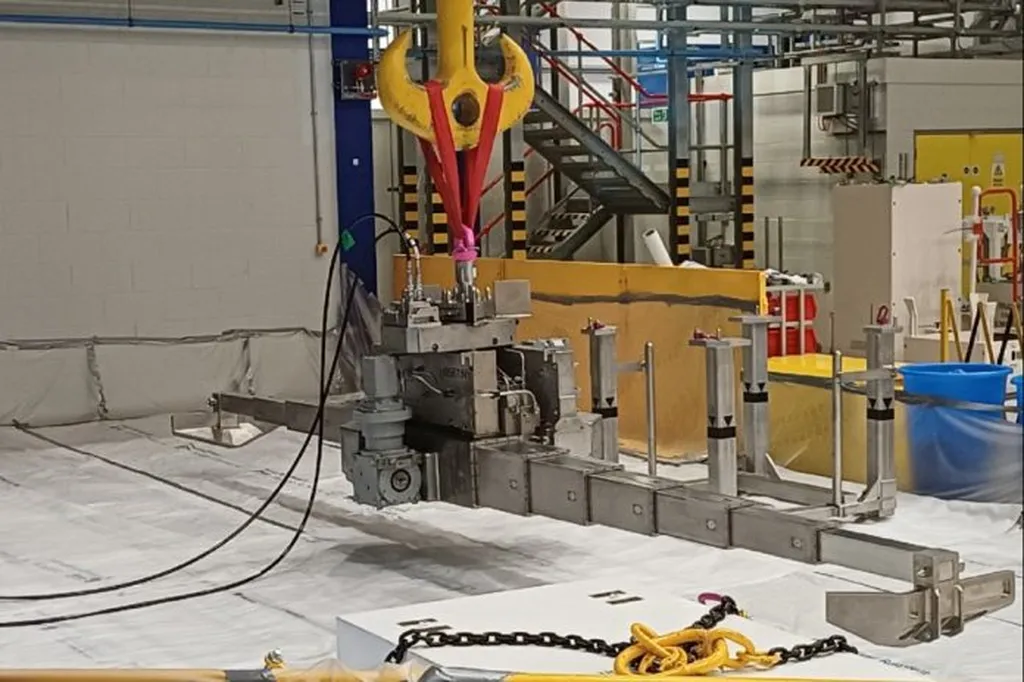Sellafield teams have achieved a significant milestone in the UK’s nuclear decommissioning efforts, successfully removing 70 tonnes of radioactive waste from the Magnox Swarf Storage Silo, one of the site’s most hazardous legacy facilities. This progress marks a substantial step forward in managing the UK’s nuclear legacy, as the waste is now placed into interim long-term safe storage. However, the success has also presented a new challenge, a common occurrence in the complex world of nuclear decommissioning.
Phil Reeve, head of legacy silos for Sellafield Ltd, explained the issue: “As we’ve scooped waste out of compartment 10 in the silo, we’ve dug a 7-metre crater in the middle of it. This creates a risk that the waste around the edges will suddenly collapse into it.” To overcome this challenge, Sellafield teams have turned to an innovative solution inspired by a traditional gardening tool.
Enter the Sellafield version of a garden rake—a 1.4-tonne machine that extends its stainless-steel arms outward, then pulls nuclear waste into the centre, smoothing it out. “The rake has been developed alongside the retrieval machine. So, it’s a big moment to see it successfully deployed in an active environment for the first time,” Reeve commented.
Andrew Prince, a team leader at the Magnox Swarf Storage Silo, added: “Deploying the rake for the first time in Compartment 10 was a major milestone. It’s one of the most challenging areas on the Sellafield site, and the successful operation gives us real confidence in the wider retrievals programme. This achievement reflects the dedication of a large team across Sellafield Ltd and our supply chain.”
The successful deployment of the rake is a testament to the ingenuity and perseverance of the teams involved. It also highlights the importance of nuclear decommissioning, a process that ensures the long-term safety of people and the environment once a nuclear facility reaches the end of its operational life. Over time, materials within reactors become highly radioactive, posing significant health and environmental risks if not properly managed and controlled.
Decommissioning safely removes and contains these hazards, preventing potential leaks, contamination, or accidental exposure. It also enables the responsible dismantling and disposal of radioactive components and waste, ensuring compliance with stringent national and international safety regulations. Moreover, decommissioning frees up land for future use, whether for industrial redevelopment, renewable energy projects, or environmental restoration.
The nuclear waste cleanup programme at Sellafield is a complex process that began in 2022, following two decades of careful preparation. The retrieval operation is particularly challenging due to the building’s original design in the 1960s, which did not account for future waste removal. A painstaking process was needed to retrofit an exit route, involving assembling huge retrieval machines on top of the building’s vast waste compartments, called a Silo Emptying Plant (SEP) machine. Currently, one machine is operational, with two more due to begin work soon. All retrieved material so far has come from compartment 10 in the silo.
This development in the sector could potentially accelerate the pace of nuclear decommissioning projects globally. The innovative use of adapted tools and machinery, like the garden rake, could inspire similar solutions in other challenging environments. Furthermore, the success at Sellafield underscores the importance of long-term planning and investment in nuclear decommissioning technologies, which could drive further advancements in the field. As the world grapples with the legacy of nuclear power, the lessons learned at Sellafield could prove invaluable in shaping the future of nuclear decommissioning.

